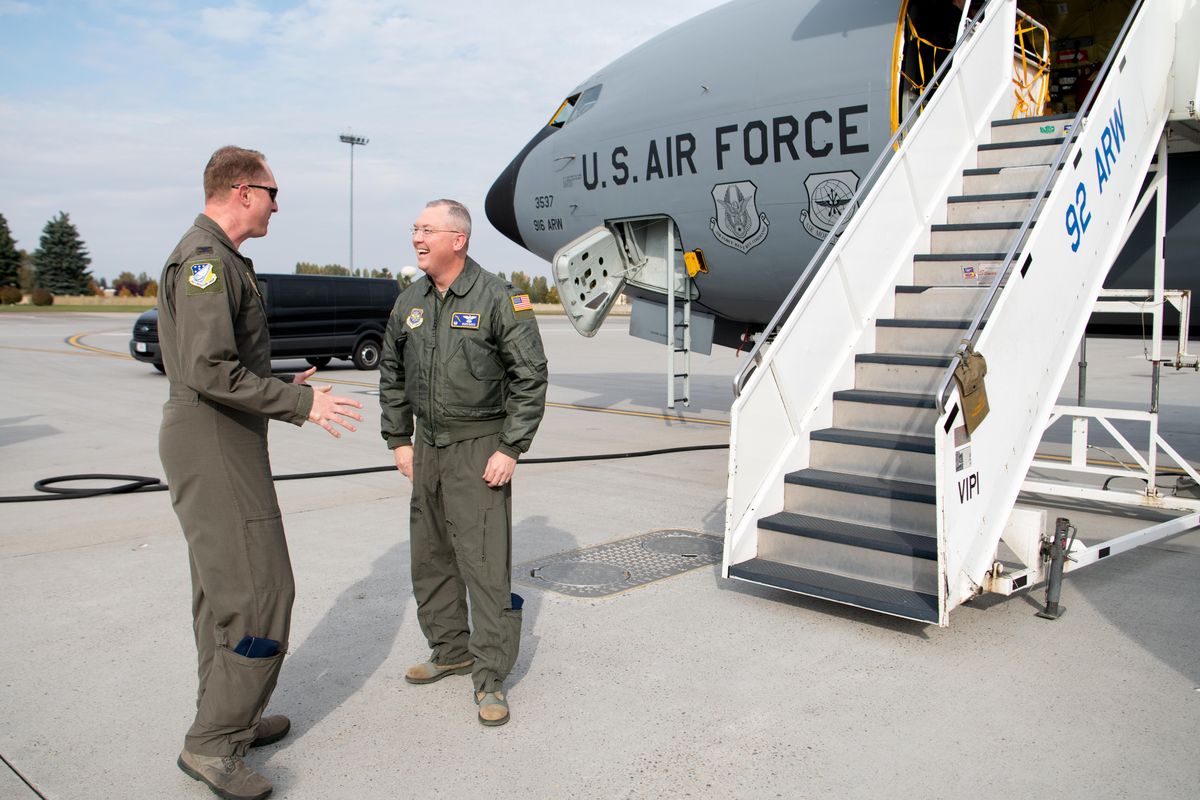Air refueling squadron touches back down at Fairchild, will bring 400 new service members

The first of 12 KC-135 Stratotanker aircraft arrived at Fairchild Air Force Base on Wednesday, ahead of the reactivation of the historic 97th Air Refueling Squadron.
The redeployed planes will bring about 400 service members and their families to the area and make Fairchild Air Force base the largest tanker-refueling wing in the Air Force.
“We are the center of excellence for air refueling, which essentially is the backbone of our global reach capability,” said Col. Gene Jacobus, vice commander of the 92nd Air Refueling Wing. “We like to think that we put the ‘global’ in ‘global reach.’ ”
Two more KC-135s will arrive at Fairchild this month from bases slated to receive newer KC-46s as replacements. All 12 KC-135s will be in place by February.
The transfer of the planes involved years of planning and a push from Washington government leaders for the Air Force to place tankers at Fairchild.
“We’ve always talked about it in the future tense,” Jacobus said. “The future is now.”
The additional planes mean Fairchild will be able to refuel more planes on missions in the Middle East, Pacific, Europe and Asia. More personnel will be able to train using KC-135s at the base, and the planes can also transport cargo and perform medical evacuations.
The last large influx of service members at Fairchild was in 2017, when the 384th Air Refueling Squadron transferred from McConnell Air Force Base in Kansas. Nine KC-135s and 50 personnel were moved with the planes as McConnell made room for KC-46s.
“This is the next evolution in that growth,” said Col. Russell Davis, 92nd Operations Group Commander.

Fairchild will also replace its base operations building over the next few years and add a new flight simulator to accommodate the new squadron.
The reactivation of the squadron will bring about 1,000 new people to the area. Fairchild has no plans to construct additional housing on base, which is currently at capacity, Davis said.
“We’re really relying upon the local community to have housing available,” said Davis, who reported that the new families will inject about $19.5 million into the local economy.
Medical Lake School District Superintendent Tim Ames said he expects many students to end up in neighboring school districts due to a lack of housing on base and in Medical Lake.
Ames said schools have not received any calls from parents for mid-year registration. He said he was informed that about 100 of the new service members would have school-aged children.
The district lost about 60 military students at the end of last year and has regained about the same amount so far, Ames said. The district normally has around 800 military students who comprise some 45% of the total student body.
About 250 students with military parents choice into the school district each year, and most of them go to Michael Anderson Elementary School, which is on base, Ames said.
“We’re just kind of waiting to see as the squadron comes in,” Ames said.
Fairchild expects service members to trickle into the area over the next several months as planes are relocated.
The base will officially reactivate the 97th Air Refueling Squadron during a ceremony Friday, when Lt. Col Cindy Dawson takes command.
The squadron was stationed at Fairchild in 1994 and deactivated in 2004.
In 1949, the squadron was the first to use B-29s outfitted with booms to refuel other aircraft during flight as is standard practice today. It was also the first squadron to air refuel at night.
A Fairchild crew traveled to Wright-Patterson Air Force Base in Ohio in August to retrieve a box of squadron memorabilia, including awards and photos. It also contained the squadron’s guidon, which will be use in the reactivation ceremony.
“It’s got a lot of history,” Davis said.